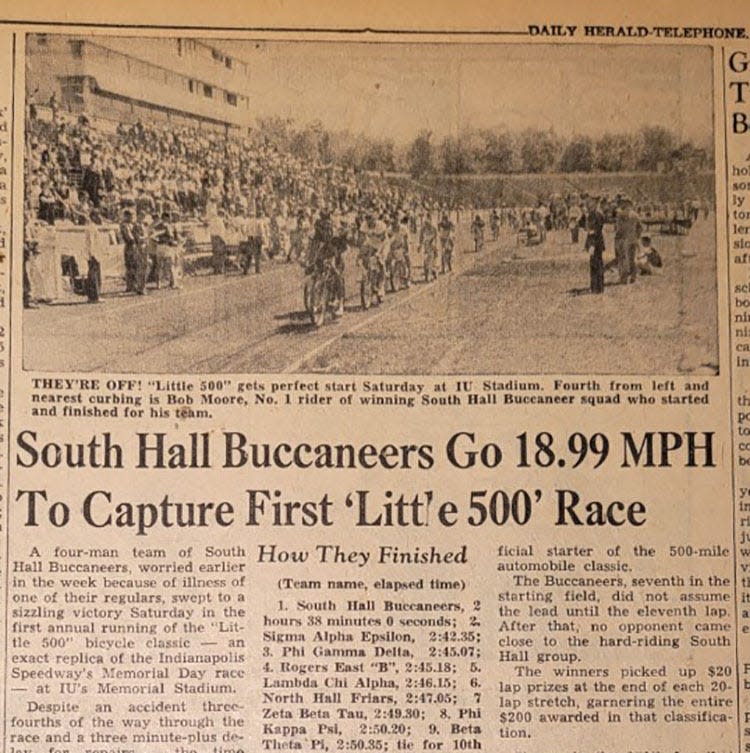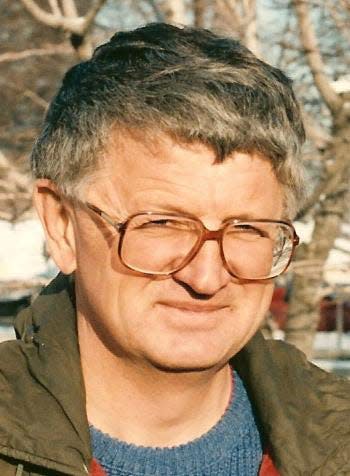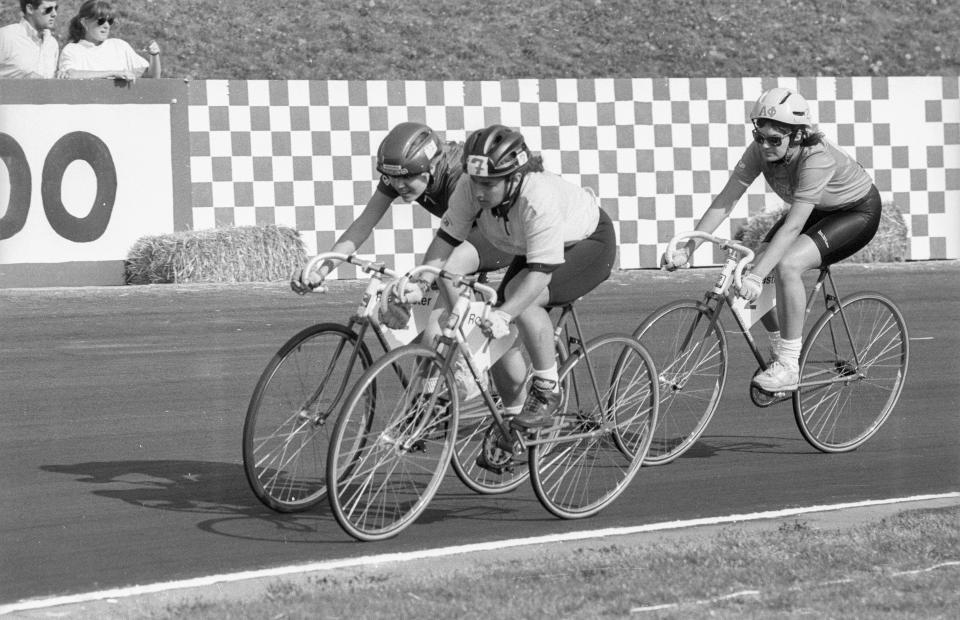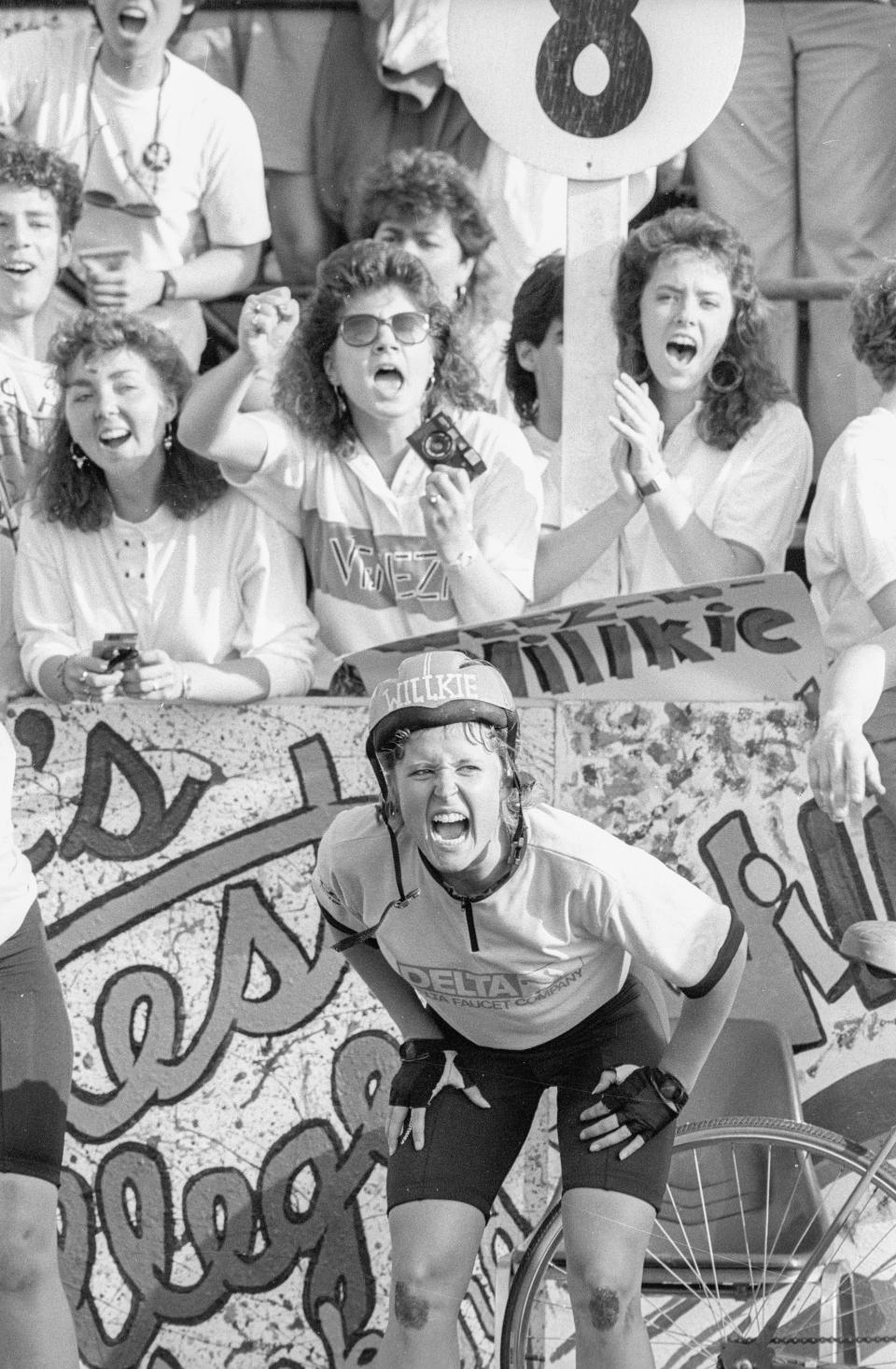IU Little 500: Ahead of the 2022 race, here are the top moments in its history
The Little 500 has had a number of memorable moments in its storied 71-year history. With the women's and men's races set for Friday and Saturday, we're taking at a look at a few of them. Feel free to reminisce on your own as you read a few of ours.

Little 500: What you need to know about races, IU festivities this weekend
May 12, 1951: First race
About 7,000 gathered at the old Memorial Stadium on 10th street to witness the brainchild of then IU Foundation executive director Howdy Wilcox, who was looking for a way to raise funds for student scholarships. He had stumbled upon students holding an informal bike race on campus and and idea was born.
The South Hall Buccaneers won by more than a mile, finishing in 2 hours 38 minutes, more than four minutes ahead of the runner-ups.
Before long, under new IUSF head Bill Armstrong, the crowds swelled and the race became an institution and just one of many activities that took place over a mid-May weekend.
The Little 500 Extravaganza the Friday before each race saw the likes of stars such as Bob Hope, Andy Williams and Connie Francis entertain large crowds. It grew to the point 50,000 watched a concert by John Melencamp in 1986.
1955: The Mini 500
The Little 500 was a men's only race for its first 37 years.
To balance things out a bit a women's only Mini 500 tricycle race was started. It took place in Assembly Hall the week before the men's race. It eventually became co-ed when the Women's Little 500 was started, and faded away in the early 2000s.
1962: Breaking Away, Part 1
Steve Tesich of East Chicago was a rider for Phi Kappa Psi when it won its fourth Little 500 race in 1962, led by the now legendary David Blaise, ironically enough from Speedway, Indiana. At the time, they set a meet record time of 2:17:26.

The experience made a lasting impression on Tesich, who was inspired to write the screen play for the 1979 classic movie, "Breaking Away." Blaise, who rode 139 of the 200 laps, was also basis for the lead character Dave Stohler (Dennis Christopher), who leads his townie 'Cutters' team to victory. He was named after Phi Kappa Psi's manager, Bob Stohler, who still lives in Bloomington.
1968: Protest to end discrimination
On the Friday before that year's race, about 50 Black students set up camp inside the stadium to protest discriminatory clauses in the national charters of fraternities on campus.
The group was led by Rollo Turner; Robert Johnson, president of the Afro-Afro-American Students Association and IU basketball player Kenny Newsome.
The students barricaded themselves within the stadium and vowed to block the Little 500 race from taking place unless all involved fraternities provided proof that such clauses were either eliminated or would no longer be honored at IU.
IU president Elvis Stahr encouraged the Greek houses to comply with the demands and all but one agreed to meet the group's requirements. The holdout, Phi Delta Theta, was removed from the race.
The race was delayed by only a day, due as much to foul weather as well as the protest.
1984: Breaking Away, Part II
The team, which took its name from the movie "Breaking Away," wrote its own real life Hollywood ending, becoming the first independent team in the 34-year history of the event to win the Little 500.
Randy Strong, Scott Senese, Adam Beck and Adam Giles, who took the team across the finish line, etched their name in the record books. They were all exiles of the Delta Chi fraternity and trained without sponsorship until qualifying for the race, when Johnson Creamery stepped up.
No team has won more than the 14 titles earned by the Cutters.
1986: Records and more records
The Cutters came back just two years later to win their second title and did so in front of a record crowd of 31,908, an MTV audience, and in a record time of 2:01:44 that still stands to this day.
The odds were long of pulling off such a feat as the Cutters lost their top rider, Vince Hoeser, who broke his collarbone during a practice run just days before the race. But Jay Polsgrove, who took over the lead role, piling up over 100 laps, George Carlin and Chris Gutowsky couldn't be stopped.
1988: First women's race

In 1987, an all-women's team from Kappa Alpha Theta attempted to qualify for the men's race and ended up 34th, missing by one spot.
Thus on April 22, 1988, the first Women's Little 500 was held with 30 teams. It was just 100 laps (25 miles), half the distance of the men's race.
A crowd of 15,000 saw the Willkie Sprinters, made up of Kirsten Swanson, Amy Tucker, Kerry Hellmuth and Louise Elder, win in 1 hour, 10 minutes, 52 seconds. They beat Kappa Alpha Theta by nine seconds.

2004: Breaking Away, Part III
One of the more controversial endings in men's Little 500 history occurred on the 25th anniversary of Breaking Way, and, of course, involved a Cutters team with four Little 500 rookies.
With two laps to go, the Cutters and Alpha Tau Omega, along with top-seeded Team Major Taylor, Phi Gamma Delta, and Briscoe were neck and neck. But a crash on the first turn of Lap 198 took down the latter three, leaving the Cutters' Chris Vargo, a Bloomington South grad, and Alpha Tau Omega omega man Hans Arnesen, 2003's Rookie of the Year.
Arnesen had a slight edge on the last lap so Vargo ducked outside looking for better traction to make a move. The two made contact with Arnesen crossing first. But the judges conferred and ruled the ATO rider had impeded Vargo by drifting out and not keeping his line.
The two second penalty was enough to give the Cutters the title in 2:06:34.
2005: Destiny denied
It seemed like divine intervention might lift Kappa Kappa Gamma to a repeat women's title, the team biking in honor of sorority sister Ashley Crouse, who had been tragically killed in a traffic accident outside the sorority just days before.
With Crouse's parents watching on from the third row of the stands, her sisters gave all they had to the memory of a woman they helped bury the day before. KKG led by half a lap, but was caught by champion Teter and Kappa Alpha Theta to settle for third.
"Our house was behind us win or lose," senior rider Meredith Horner said. "We knew any way we finished, Ashley would've been proud."
2006: Breaking Away, Part IV
Two years later, Arnesen would finally get his title and without a lick of controversy in 2006 when he was able to lap the field during his opening 41-lap leg. ATO went on to win its first title since 1971 by 35 seconds.
The women's race was just the opposite as Kappa Kappa Gamma, which had won the 2004 title by less than a second, edged Kappa Delta and Alpha Gamma Delta by less than two seconds.
Contact Jim Gordillo at jgordillo@heraldt.com and follow on Twitter @JimGordillo.
This article originally appeared on The Herald-Times: "Breaking Away" moments top the most memorable Little 500 moments at IU
